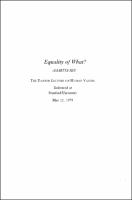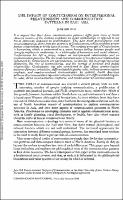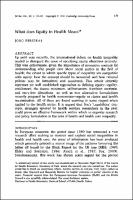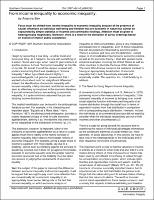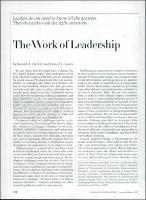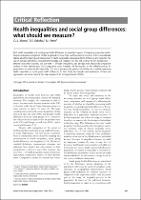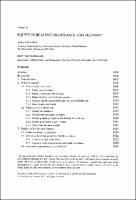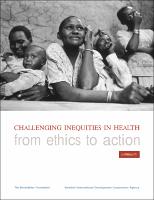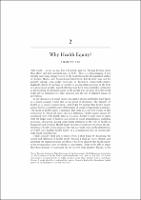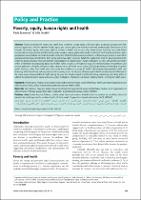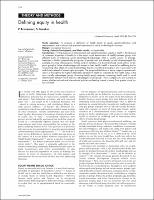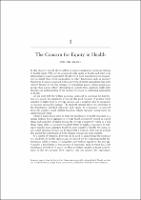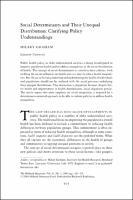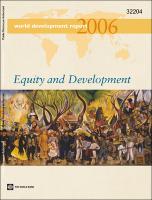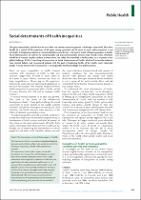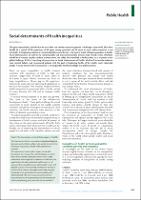Browsing by Issue Date
Now showing items 1-20 of 229
-
Equality of What?
(Cambridge: Cambridge University Press., 1979)
Well-being is not just a question of the wealth or pleasure that a person has; it is a question of how people manage to live their lives and the ability they have to do certain things that are important to them. This was the argument put forward by Professor Amartya Sen in 1979. In his seminal Tanner Lecture – ‘Equality of What?’, Sen unites economics and philosophy to explore how a person’s well-being might best be measured. It was the first in a series of writings in which he developed his capability approach. This focuses on the actual capability ... -
The impact of Confucianism on interpersonal relationships and communication patterns in east Asia
(Communication Monographs, 1988)
It is argued that East Asian communication patterns differ from those of North America because of the Eastern emphasis on social relationships as opposed to the North American emphasis on individualism. This East Asian preoccupation with social relationships stems from the doctrines of Confucianism, which considers proper human relationships to be the basis of society. The cardinal principle of Confucianism is humanism, which is understood as a warm human feeling between people and strongly emphasizes reciprocity. As a philosophy of humanism and ... -
What does Equity in Health Mean?
(Journal of Social Policy, 1993)
Up until very recently, the international debate on health inequality tended to disregard the issue of specifying equity objectives precisely. This was unfortunate, given the importance of normative analysis for understanding why people care about social justice in the field of health; the extent to which specific types of inequality are compatible with equity; how the concept should be measured; and how rational policies may be formulated and monitored. This article critically appraises six well established approaches to defining equity—egality, ... -
From income inequality to economic inequality.
(Southern Economic Journal, 1997)
Focus must be shifted from income inequality to economic inequality because of the presence of causal influences on individual well-being and freedom that are economic in nature but cannot be expounded by simple statistics of incomes and commodity holdings. Attention must be given to heterogeneous magnitudes. Moreover, there is a need for the derivation of partial orderings based on explicit or implicit public acceptance. -
The work of leadership
(Harvard Business School Publishing, 1997)
To stay alive, Jack Pritchard had to change his life. Triple bypass surgery and medication could help, the heart surgeon told him, but no technical fix could release Pritchard from his own responsibility for changing the habits of a lifetime. He had to stop smoking, improve his diet, get some exercise, and take time to relax, remembering to breathe more deeply each day. Pritchard’s doctor could provide sustaining technical expertise and take supportive action, but only Pritchard could adapt his ingrained habits to improve his long-term health. ... -
Human rights and asian values
(1997)
In 1776, just when the Declaration of Independence was being adopted in this country, Thomas Paine complained, in Common Sense, that Asia had “long expelled” freedom. In this lament, Paine saw Asia in company with much of the rest of the world (America, he hoped, would be different). Singapore warned that “universal recognition of the ideal of human rights can be harmful if universalism is used to deny or mask the reality of diversity.” The Chinese delegation played a leading role in emphasizing regional differences and in making sure that the ... -
Human Rights and Asian Values
(Carnegie Council on Ethics and International Affairs, 1997) -
Health inequalities and social group differences: what should we measure?
(Bulletin of the World Health Organization, 1999)
Both health inequalities and social group health differences are important aspects of measuring population health. Despite widespread recognition of their magnitude in many high- and low-income countries, there is considerable debate about the meaning and measurement of health inequalities, social group health differences and inequities. The lack of standard definitions, measurement strategies and indicators has and will continue to limit comparisons Ð between and within countries, and over time Ð of health inequalities, and perhaps more ... -
Chapter 34 Equity in health care finance and delivery
(Handbook of Health Economics, 2000)
The paper surveys the economics literature on equity in health care financing and delivery. The focus is, for the most part, on empirical work, especially that involving intemational and temporal comparisons. There is, however, some discussion of the concept and definition of equity. The empirical sections cover the literature on equity in health care financing (progressivity and horizontal equity of health care financing arrangements), equity in health care delivery (horizontal equity in the sense of treating persons in equal need similarly), ... -
Challenging inequities in health : from ethics to action : summary
(Oxford University Press, New York, 2001)
Challenging Inequities in Health, was conceived as a response to the following: 1. Concerns about widening “health gaps” both between and within countries; 2. A disproportionate research focus on inequalities in health in the “North” to the relative neglect of the “South”; and 3. Inadequate analytic tools and pragmatic policies to redress health inequities. Through a collective effort of researchers and practitioners called the Global Health Equity Initiative (GHEI), a set of in-depth country studies and conceptual analyses on health equity ... -
Why health equity?
(2001) -
Poverty, equity, human rights and health
(The World Health Organization, 2003)
Those concerned with poverty and health have sometimes viewed equity and human rights as abstract concepts with little practical application, and links between health, equity and human rights have not been examined systematically. Examination of the concepts of poverty, equity, and human rights in relation to health and to each other demonstrates that they are closely linked conceptually and operationally and that each provides valuable, unique guidance for health institutions’ work. Equity and human rights perspectives can contribute concretely ... -
Poverty, equity, human rights and health
(Bulletin of the World Health Organization, 2003)
Those concerned with poverty and health have sometimes viewed equity and human rights as abstract concepts with little practical application, and links between health, equity and human rights have not been examined systematically. Examination of the concepts of poverty, equity, and human rights in relation to health and to each other demonstrates that they are closely linked conceptually and operationally and that each provides valuable, unique guidance for health institutions’ work. Equity and human rights perspectives can contribute concretely ... -
Defining equity in health
(Journal of Epidemiology & Community Health, 2003)
Study objective: To propose a definition of health equity to guide operationalisation and measurement, and to discuss the practical importance of clarity in defining this concept. Design: Conceptual discussion. Setting, Patients/Participants, and Main results: not applicable. Conclusions: For the purposes of measurement and operationalisation, equity in health is the absence of systematic disparities in health (or in the major social determinants of health) between groups with different levels of underlying social advantage/disadvantage—that ... -
Revisiting the Asian Values Argument used by Asian Political Leaders and its Validity
(Indonesian Quarterly, 2004) -
The Concern for Health Equity
(Oxford University Press 2004, 2004) -
Social Determinants and Their Unequal Distribution: Clarifying Policy Understandings
(The Milbank Quarterly, 2004-03)
Public health policy in older industrialized societies is being reconfigured to improve population health and to address inequalities in the social distribution of health. The concept of social determinants is central to these policies, with tackling the social influences on health seen as a way to reduce health inequalities. But the social factors promoting and undermining the health of individuals and populations should not be confused with the social processes underlying their unequal distribution. This distinction is important because, despite ... -
World Development Report 2006: Equity and Development
(World Bank Publications, 2005)
The World Development Report 2006: Equity and Opportunitypresents a social development strategy organized around the themes of social inclusion, cohesion, and accountability. It examines equality of opportunities--a potentially important factor affecting both the workings of the investment environment and the empowerment of the poor--by building on and extending existing accountability frameworks presented in the 2005Report. -
Social determinants of health inequalities
(The Lancet, 2005)
The gross inequalities in health that we see within and between countries present a challenge to the world. That there should be a spread of life expectancy of 48 years among countries and 20 years or more within countries is not inevitable. A burgeoning volume of research identifies social factors at the root of much of these inequalities in health. Social determinants are relevant to communicable and non-communicable disease alike. Health status, therefore, should be of concern to policy makers in every sector, not solely those involved in ... -
Social determinants of health inequalities
(The Lancet, 2005)
The gross inequalities in health that we see within and between countries present a challenge to the world. That there should be a spread of life expectancy of 48 years among countries and 20 years or more within countries is not inevitable. A burgeoning volume of research identifies social factors at the root of much of these inequalities in health. Social determinants are relevant to communicable and non-communicable disease alike. Health status, therefore, should be of concern to policy makers in every sector, not solely those involved in ...

